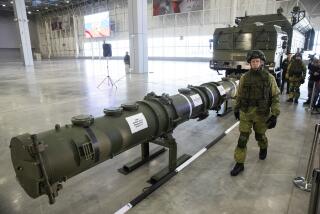New Hard Line Ties A-Arms Cut, Razing of Soviet Radar Site
GENEVA — In a major policy reversal, the United States today formally linked any reduction in strategic nuclear weapons to the full dismantling of a Soviet radar array in Siberia.
The new hard-line position clearly involved a decision at the highest levels of the Reagan Administration with all questions referred to Washington.
An American arms delegation statement denounced the still-incomplete radar at Krasnoyarsk as a violation of the 1972 anti-ballistic missile treaty.
Cuts ‘Impossible’
It said strategic arms cuts are “impossible” unless the facility is destroyed and additionally warned that Washington “reserves all its rights” to possibly repudiate the ABM treaty because Krasnoyarsk is a “material breach” of its terms.
Unlike Moscow, the United States never previously tied agreements at Strategic Arms Reduction Talks, START, to other offensive or defensive weapons systems.
It always rejected Soviet linkage since talks began in 1985 between the aim of 50% cuts in long-range nuclear weapons and strict limits on the U.S. Strategic Defense Initiative, known as “Star Wars.”
Moscow charges that any advanced SDI testing would violate the ABM accord that it said should be extended with “strict compliance” for at least nine or 10 years.
The new U.S. position was announced after a week of inconclusive talks at the third five-year review of the ABM treaty.
U.S. arms spokesman Terry Shroeder was only authorized to issue a short reply to questions about the policy switch.
“Because of the seriousness of the issue, including the potential for a declaration by the United States of a material breach (of the ABM treaty), we are referring all questions to Washington,” Shroeder said.
‘A Significant Violation’
“The Soviet Union’s deployment of a large phased-array radar near Krasnoyarsk constitutes a significant violation of a central element of the ABM treaty,” the U.S. statement said. “The Krasnoyarsk violation is very serious, particularly when it is recognized that the radar constitutes one of a network of such radars that have the inherent potential for attack assessment in support of ballistic missile defense.
“The United States has also made it clear that the continuing existence of the Krasnoyarsk radar makes it impossible to conclude any future arms agreements in the START or defense and space areas.”
Mikhail S. Gorbachev ordered work stopped last year at Krasnoyarsk despite his contention that the radar is for tracking satellites and not part of an ABM project.
Gorbachev offered dismantling of the facility if Washington, as part of a strategic arms agreement, accepts a parallel accord limiting space defense systems.
Demand Rejected
Gen. William F. Burns, director of the Arms Control and Disarmament Agency and chief ABM delegate, flatly rejected that demand in a speech in Geneva on Tuesday.
“The Strategic Defense Initiative is not something that we’ll bargain away or modify with crippling provisions,” Burns said in a speech. “We will research it, test it, and, if it works, deploy it.”
In its statement after the ABM review meeting, the United States said a construction freeze at Krasnoyarsk would be insufficient.
More to Read
Sign up for Essential California
The most important California stories and recommendations in your inbox every morning.
You may occasionally receive promotional content from the Los Angeles Times.










